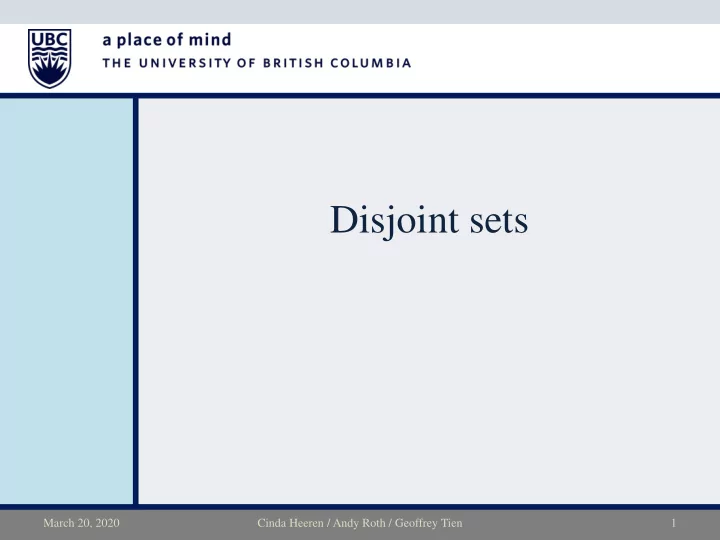

Disjoint sets March 20, 2020 Cinda Heeren / Andy Roth / Geoffrey Tien 1
A data structure for disjoint sets • Maintains a collection 𝑇 = 𝑡 0 , 𝑡 1 , … , 𝑡 𝑙 of disjoint sets • Each set has a representative member • Required operations: – void MakeSet(int k); – void Union(int x, int y); – int Find(int x); • Let's start with an array-based structure 3 5 6 0 1 4 2 7 Cost of Find()? Cost of Union()? representative 0 0 2 3 0 3 3 2 index 0 1 2 3 4 5 6 7 March 20, 2020 Cinda Heeren / Andy Roth / Geoffrey Tien 2
A better structure for disjoint sets "Uptrees" • A tree where a node points to its parent – still array-based, but representative is the root of the tree • if array value is −1 , then the index is a root node • otherwise, the array value is the index's parent • 𝑦 and 𝑧 are in the same tree ⇔ 𝑦 and 𝑧 are in the same set 1 1 2 2 0 0 0 2 3 3 1 3 – 1 – 1 – 1 – 1 – 1 – 1 – 1 parent parent parent 1 2 1 1 2 index index index 0 1 2 3 0 1 2 3 0 1 2 3 March 20, 2020 Cinda Heeren / Andy Roth / Geoffrey Tien 3
Tree-based disjoint sets int DisjointSets::Find(int x) { Running time? if (parent[x] < 0) return x; else return Find(parent[x]); } – It depends on the height of the trees in the disjoint sets • average: 𝑃 log 𝑜 , worst: 𝑃 𝑜 , best: 𝑃 1 March 20, 2020 Cinda Heeren / Andy Roth / Geoffrey Tien 4
Tree-based disjoint sets • Union: given arbitrary indices 𝑦 and 𝑧 , join their trees – naïvely: set root of 𝑦 to 𝑧 , or vice-versa – slightly better: set root of 𝑦 to root of 𝑧 , or vice-versa 3 Union(0, 1); 2 Union(1, 2); 0 2 1 3 1 Union(0, 3); 0 Can still end up with bad trees! March 20, 2020 Cinda Heeren / Andy Roth / Geoffrey Tien 5
"Smart" union 7 4 10 8 9 6 5 0 1 2 3 11 Keeps overall tree 6 6 6 8 10 7 4 7 7 4 5 Union by height parent height as small as possible index 0 1 2 3 4 5 6 7 8 9 10 11 Increases distance 6 6 6 8 7 10 7 7 7 4 5 Union by size parent from root for as index 0 1 2 3 4 5 6 7 8 9 10 11 few nodes as possible – both schemes guarantee that the height of the tree is 𝑃 log 𝑜 • but we will ignore the proof for now March 20, 2020 Cinda Heeren / Andy Roth / Geoffrey Tien 6
Path compression • During a Find operation, we follow a path up the tree through a sequence of nodes – i.e. we look up a number entries in an array, where each lookup is 𝑃 1 • Why don't we add an additional 𝑃 1 operation for each entry we process? – Set the parent of each node along the path, to the root found at the end of the path 7 7 4 4 5 Find(5); 10 10 11 5 Find(10); 11 March 20, 2020 Cinda Heeren / Andy Roth / Geoffrey Tien 7
Readings for this lesson • Wikipedia – https://en.wikipedia.org/wiki/Disjoint-set_data_structure • Next class: – Carrano & Henry: Chapter 20.1 – 20.2 (Graph terminology and ADT) March 20, 2020 Cinda Heeren / Andy Roth / Geoffrey Tien 8
Recommend
More recommend